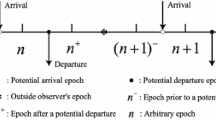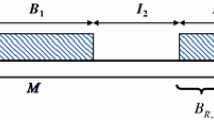Abstract
We consider a discrete-time GI-G-1 queueing system with server vacations. Vacations occur whenever the queue becomes empty or whenever a timer expires. When the timer expires one of the following four actions are considered: the server completes transmission of the present packet before leaving for a vacation, the service immediately leaves for a vacation and the interrupted packet's service is either continued, repeated or resampled and repeated after the vacation. Using a probability generating functions approach, we derive various performance measures such as moments of the buffer contents at various time epochs in equilibrium and moments of the packet delay in equilibrium. By means of an example, we then compare the operation modes under consideration.
Similar content being viewed by others
References
T. Altiok, Queueing modeling of a single processor with failures, Performance Evaluation 9 (1988/1989) 93-102.
H. Bruneel, Performance of discrete-time queueing systems, Comput. Oper. Res. 20 (1993) 303-320.
B.T. Doshi, Queueing systems with vacations-a survey, Queueing Systems 1 (1986) 29-66.
I. Eliazar and U. Yechiali, Randomly timed gated queueing systems, SIAM J. Appl. Math. 59 (1998) 423-441.
I. Eliazar and U. Yechiali, Polling under the randomly timed gated regime, Stochastic Models 14 (1998) 79-93.
D. Fiems, B. Steyaert and H. Bruneel, Discrete-time queueing model with general service-time distribution and two-state Markovian server interruptions, in: Proc. of the 8th IFIP Workshop on Performance Modelling and Evaluation of ATM & IP Networks, IFIP ATM & IP 2000, Ilkley, 17-19 July 2000, pp. 25/1-25/13.
D. Fiems, B. Steyaert and H. Bruneel, Discrete-time queues with general service times and general server interruptions, in: Internet Performance and Control of Network Systems, Proc. of SPIE, Vol. 4211, Boston, USA, 6-7 November 2000.
D. Fiems, B. Steyaert and H. Bruneel, Performance evaluation of CAI and RAI transmission modes in a GI-G-1 queue, Comput. Oper. Res. 28(13) (2001) 1299-1313.
D. Fiems, B. Steyaert and H. Bruneel, Service strategies for discrete-time GI-G-1 queues subjected to interruptions, Presentation at the Joint IFIP WG 6.1, 6.2/4, 6.3 and 7.3 Workshop on Performance/Modelling and Performability and Specification for Performance Modelling and Verification/ Testing of Computer Communication Systems, Cape Town, South Africa, May 2001.
I. Frigui and A. Alfa, Analysis of time-limited polling system, Comput. Commun. 21 (1998) 558-571.
K.K. Leung and D.M. Lucantoni, Two vacation models for token-ring networks where service is controlled by timers, Performance Evaluation 20 (1994) 165-184.
H. Takagi, A survey of queueing analysis of polling models, in: Proc. of the 3rd IFIP Internat. Conf. on Data Communication Systems and Their Performance, Rio de Janeiro, Brazil, 22-25 June 1987.
F.A. Van der Duyn Schouten and S.G. Vanneste, Maintenance optimization of a production system with buffer capacity, European J. Oper. Res. 82 (1995) 232-338.
J. Walraevens, B. Steyaert and H. Bruneel, Performance analysis of the system contents in a discretetime non-preemptive priority queue with general service times, JORBEL (2001).
Author information
Authors and Affiliations
Rights and permissions
About this article
Cite this article
Fiems, D., Bruneel, H. Analysis of a Discrete-Time Queueing System with Timed Vacations. Queueing Systems 42, 243–254 (2002). https://doi.org/10.1023/A:1020571814186
Issue Date:
DOI: https://doi.org/10.1023/A:1020571814186




